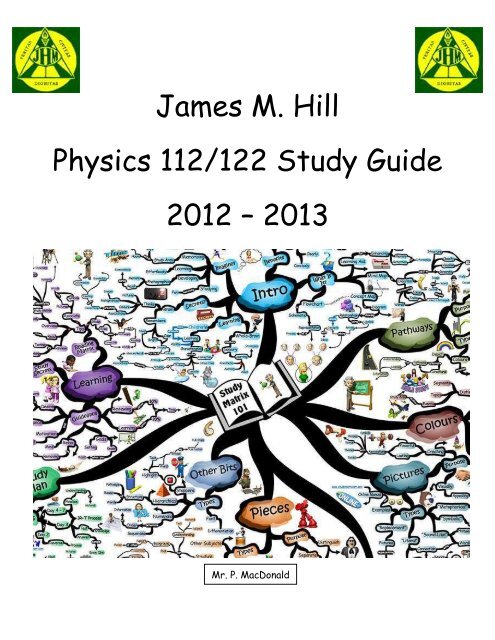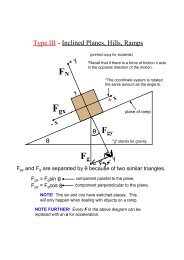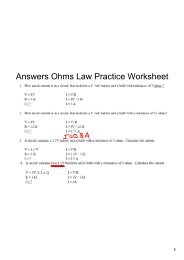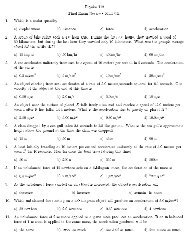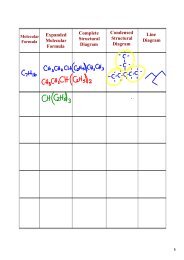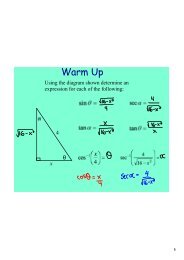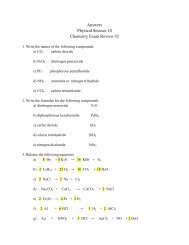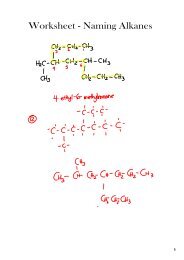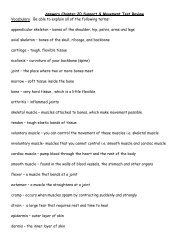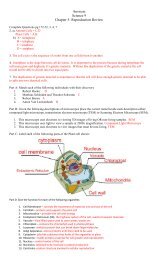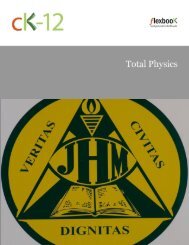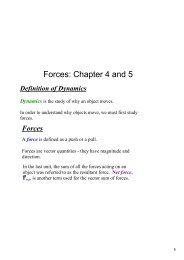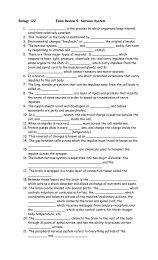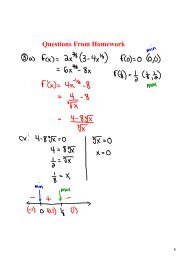Physics Study Guides.pdf - James M. Hill Memorial High School
Physics Study Guides.pdf - James M. Hill Memorial High School
Physics Study Guides.pdf - James M. Hill Memorial High School
You also want an ePaper? Increase the reach of your titles
YUMPU automatically turns print PDFs into web optimized ePapers that Google loves.
<strong>James</strong> M. <strong>Hill</strong><strong>Physics</strong> 112/122 <strong>Study</strong> Guide2012 – 2013Mr. P. MacDonald
MotionBig Picture<strong>Study</strong> <strong>Guides</strong>Everything is in motion. For example, we are all moving around the sun. This means that when we talk about motion,we must look at it relative to something else. The motion of objects through space is one of the first subjects of studyfor early physicists, but it took a very long time before motion was fully understood. To describe motion, we use ratessuch a velocity, speed, and acceleration. Throughout this study guide, assume negligible air resistance.<strong>Physics</strong>Disclaimer:Key TermsDisplacement: The distance an object has moved from its starting position. SI units: mSpeed: The rate at which an object covers distance (distance/time). SI units: m/sVelocity: Speed in a given direction. SI units: m/sAcceleration: The rate at which an object’s velocity is changing (velocity/time). Like velocity, acceleration is a vector.SI units: m/s 2Projectile Motion: The non-linear path an object takes when moving under the constant acceleration of gravity.Free Fall: Objects falling due to gravity only. Example: an apple falling from a tree is in free fall.Describing Ions MotionDisplacement vs. DistanceDisplacement and distance both measure a changein position. Displacement is a vector quantity, whiledistance is a scalar.If an object moves in one direction and then returns toits original position, the total distance will be a positivenumber and the total displacement will be 0. Thediagram below illustrate the concept of displacement.AccelerationUsually we use “acceleration” to mean speeding upand “deceleration” to mean slowing down. In physics,acceleration is a vector quantity that could refer tospeeding up, slowing down, or even changing direction.Careful: positive acceleration does not alwaysmean speeding up and negative accelerationdoes not always means slowing down.Think of an acceleration as a push. We can definepositive acceleration as a push to the right and negativeacceleration as a push to the left.If an object has a negative velocity, meaning that theobject is moving towards the left, then a positiveacceleration pushing the object to the right will cause theobject to slow down.• If the velocity and acceleration are in the same direction,the object speeds up. If not, the object slowsdown.Speed vs. VelocitySpeed is a scalar quantity that measures how fast anobject is moving. In comparison, velocity is a vectorquantity. Velocity is speed with a direction. Objectsmoving at the same speed can have different velocitiesif they are moving in different directions.Instantaneous vs. AverageThere are two types of speed, velocity, and acceleration:instantaneous and average.Instantaneous refers to a single moment in time, whileaverage refers to over a period of time.For example, we can say a car is moving at the speed of25 mph, but if we say the car is moving at 25 mph to thenorth, then we are stating its velocity.NotesThis guide was created by Christopher Addiego and Catherine Wu. To learnmore about the student authors, visit http://www.ck12.org/about/about-us/team/interns.Page 1 of 4v1.1.10.2012this study guide was not created to replaceyour textbook and is for classroom or individual use only.
<strong>Physics</strong>Motion cont.Graphs of MotionDistance vs. TimeBelow is a graph of distance versus time. The slope of the curve represents the speed. As we can see, until t = 6 s,the object is moving at a constant speed of. After t = 6 s, its speed is 0, meaning the object is at rest. Then, at11 s, the object starts to move in the opposite direction. After 17 s, it has returned to its original position, resulting ina total displacement of 0.Velocity vs. TimeBelow is a graph of velocity versus time. The sloperepresents acceleration. If the velocity curve is aline (has a constant slope), we know that there isa constant acceleration. The area under the velocitycurve is equal to the change in displacement.Acceleration vs. TimeSimilarly, for acceleration, the area under the accelerationcurve is equal to the change in velocity. Below is a graphof acceleration versus time.Projectile MotionProjectile motion is a type of two-dimensional motion where an object moves horizontally (in the x-axis) and vertically(in the y-axis). The x- and y-components of any object’s velocity vector are completely independent of each other. Thediagram on the right shows the path and velocity vectors of an object in projectile motion.• At the top of its flight, when the objectstops rising and is about to fall, thevertical speed of an object is zero.• Air resistance is ignored, so the horizontalcomponent of velocity stays constant.• The vertical component of velocity doesnot stay constant due to gravity - theobject is in free fall along the verticaldirection.Page 2 of 4
Motion Problem GuideGeneral Guidelines• Always define a coordinate system for the problem! Define the positive and negative directions.• Make sure your units make sense.Important EquationsSample Problem<strong>Physics</strong>• All equations are only valid for constant acceleration• In one dimension, vectors can only point in twodirections, typically labeled + and -. The onedimensional vectors below can be treated like scalarswith the signs indicating direction.Two cities are 33 miles apart by freeway, where thespeed limit is 65 mph. If it took you 45 minutes to getfrom one city to the other, what was your average speed?SolutionSince we know the distance and the time, we can easilyfind the speed, which is just distance over time.x - displacementv - velociyv o - initial velocitya - accelerationt - timeΔ - change in (final value - initial value)Free FallAn object thrown into the air is in free fall when it is moving up and falling down. At the maximum height, the object’svelocity is 0 as it changes direction. If the object is at the same height before and after it is thrown, the time it takesto reach the maximum height is exactly half the total time the object spends in the air. The path up and the path downis identical but in opposite directions. Acceleration is always 9.8 m/s 2 .When we solve free fall problems, we usually look at only one direction (either the journey up or the journey down) sothat there is one less variable to deal with. We can do this because we know the velocit at the top is 0.Equations to use:ExampleA tennis ball is hit up into the air and spends a total of 8 seconds in the air. How high does it reach before coming backdown?Solution1. Determine what is given and what needs to be found.2. Set up the equation and solve for v o .3. Set up the equation .4. Plug in values and solve for y!Given: t = 8 secondsFind: y = ??Let +y be upward and -y be the downward direction. In this example, we’re going to use the ball on its way up, so t = 4seconds, v = 0 m/s, and a = -9.8 m/s 2 .So the ball reaches a height of 78 m.Page 3 of 4
<strong>Physics</strong>Motion Problem Guide cont.Projectile MotionIn projectile motion, the acceleration in the y-direction is always -9.8 m/s 2 , while the acceleration in the x-directionis 0. If the object is thrown at an angle, the initial velocity must be broken up into x- and y-components ( ,). Like in freefall, the velocity in the y-direction at the top of the object’s path is 0 m/s.In some questions, the object is thrown at a specific angle “above the horizontal” or “below the horizontal.” In theexample and diagram below, you can see what “above the horizontal” means. “Below the horizontal” is similar, only v yand acceleration are both in the same direction.Equations to use:ExampleA man standing on a cliff throws a rock at 25° above the horizontal with an initial velocity of 15 m/s. If the rock is inthe air for 5 seconds, how tall is the cliff, and how far into the ocean does it travel?Solution1. Determine what is given and what needs to be found.2. Draw and label a diagram.3. Set up the equation for the x-and y-directions.4. Plug in values and solve!Let the initial positions x o and y o be 0 so that Δx = x - x o = x and Δy = y - y o .Given: v o = 15 m/s, t = 5 seconds, and θ = 15°Find: x and yx - directiony - directionSo the cliff is 91 m tall, and the rock travels 68 m.ExampleIn this problem, we end up with a negative y value that represents the height of the cliff because y = 0 isat the top of the cliff.If an object is launched into the air with speed at an angle on flat ground, how long will the object be in the air?SolutionSince we know that the object’s final vertical displacement is zero, we can think of its path as a parabola. We can findthe roots using the displacement equation.Start with the equation for vertical displacement.Substitute in known values. The sign changed on the second term becausewe know g is negative.Begin solving for t like we would for any quadratic.We already know the displacement is 0 at time t = 0, so the second solutionis our answer.Page 4 of 4
Newton’s LawsBig Picture<strong>Study</strong> <strong>Guides</strong>Newton’s laws form the basis for all of mechanics and describe the effects of forces on an object’s motion. Newton’slaws can be applied to all sorts of problems in mechanics and even some in electrostatics. Anytime a force is involved,Newton’s laws will determine the motion of the object the force is acting on.Key TermsInertia: An object’s resistance to changes in its motion.Force: Any push or pull. SI unit: NNormal Force (N): The reaction force exerted on anobject by the surface that is supporting it. SI unit: NFriction: The force that acts between moving materials.It always acts opposite the direction of the object’smotion or applied force (if the object isn’t moving).The frictional force f is proportional to the coefficientof friction μ, which depends on the surface the objectis moving over, and the normal force N. SI unit: NCoefficient of Static Friction: Coefficient of frictionused for objects at rest to determine how muchforce is required to make it begin moving.Coefficient of Kinetic Friction: Coefficient of frictionused for objects moving across a surface todetermine the force resisting the motion.Tension: Force on an object provided by a wire, string,cable, or similar object.<strong>Physics</strong>Disclaimer:Newton’s LawsNewton’s First LawKnown as law of inertia, it states that an object in motiontends to stay in motion and an object at rest tends tostay at rest unless acted on by an external force.• This means that an object moving with a constant velocity,speed, and direction will continue moving withthat velocity. An object that is not moving will notmove unless there a force acts on it.• The value of an object’s inertia can be measured.Mass is the measure of an object’s inertia while it isat rest.Newton’s Second LawExplains how the force acting on an object will affect itsmotion. The acceleration a (change in velocity) of anobject is directly proportional to the force F exerted on itand inversely proportional to the mass m (inertia) of theobject. F = maNewton’s Third LawThis law states that for any force exerted by one objecton another, the other object exerts an equal force in theopposite direction on the first object. For example, if aperson is pushing on a wall, the wall is also pushing backon them with an equal force in the opposite direction.• This law holds for all situations in which objects comeinto contact, even when the objects are accelerating.• While it seems like the third law would prevent theobject from moving because the reaction force wouldcancel the initial force, the two forces act on differentobjects so there is still a net force on the individualobjects.• Pairs of forces described by the third law must be: thesame type of force, exerted on two different objects,and equal in magnitude in opposite directions.• If there are multiple forces on the object, the accelerationis proportional to the net (overall) force.• Any net force causes an acceleration, but only forcesin the direction of motion causes a change in speed.• Forces applied perpendicular to direction of motionwill change the direction of motion, but not the speed.Free Body DiagramsThe forces on an object are often visualizedusing a free body diagram (FBD). FBDs areuseful for looking at the different types offorces acting on an object.Be careful when assigning signs. For each ofthe x- and y-components, remember whichdirection is positive and which is negative.Typically the “downward” direction is assignedas the negative direction, but you donot have to follow this convention as long asyour signs are consistent.Mass on a TableThis guide was created by Christopher Addiego and Catherine Wu. To learnmore about the student authors, visit http://www.ck12.org/about/about-us/team/interns.Gravity is a force that acts on all objects. Near thesurface of the Earth, the force due to gravity (F g )is equal to mg, where g is approximately 9.8 m/s 2 .• mg is what we call the weight of an object. It isnot the same thing as mass!Normal force (N) can be understood usingNewton’s third law. It is the force opposing gravityso that the net force on both objects (the massand the table) is zero. N = mgPage 1 of 3v1.1.10.2012this study guide was not created to replaceyour textbook and is for classroom or individual use only.
<strong>Physics</strong>Newton’s Laws cont.Free Body Diagrams (cont.)Objects on a RampAnother type of problem is an object on a ramp or tilted table. The normal force is still perpendicular to the table, butgravity is always pointing straight down.Gravity can be decomposed into its x- and y-components (relative to the ramp), as shown below. Because of Newton’sthird law, we know that N = mg cos θ.Friction force is always in the opposite direction of motion. In the ramp example, gravity pulls the object down theramp, so friction acts in the opposite direction (up the ramp), impeding the object’s motion.• There are two friction coefficients: the coefficient of static friction (μ s ) and the coefficient of kinetic friction(μ k ). The static coefficient is always greater than the kinetic coefficient, which is why it takes less force to keep anobject sliding along the ground than it does to make it start moving. The graph below shows the magnitude of thefriction force over time while resisting an external force.• μ s N is the static friction the block needs to overcome before it can move.• If the block is not moving, we can calculate the magnitude of static friction.• If the block is moving, use the kinetic coefficient to calculate kinetic friction.TensionFor objects attached to a string (or similar string-like objects), the force provided by the stringis called tension. This could be an object hanging from a string or an object being pulled bya string.• Usually the string is assumed to have no mass - this means that we can assume the stringwill perfectly transfer energy from one end of the string to the other.• The total force on a massless string must always be zero. This means that every point alongthe string feels two equal and opposite tension forces.• If the string is angled, make sure to decompose the tension force into components.Page 2 of 3
Newton’s Laws Problem GuideImportant EquationsF = maf = μNExampleF - forcef - force of frictionm - massμ - coefficient of frictiona - accelerationN - normal force<strong>Physics</strong>Equilibrium problems (where there is no net force) are the most common type of problem involving Newton’s laws.ExampleA block of mass m is at rest on an incline of angle θ. Solve for the the coefficient of static friction (μ) in terms of m,g, and θ.SolutionThe first step in any problem involving Newton’s laws is to draw anFBD of the situation and carefully label all the forces involved. TheFBD on the right shows all the forces all drawn from a single pointinstead of from where they’re acting so that it’s easier to visualizethe axes. In these sort of problems it is best to angle the coordinatesystem so that the x-axis is parallel to the incline. This forces us tobreak the weight vector into its components. Since the object is inequilibrium, the weight vector’s components can be matched to thenormal force and friction.Here is the mathematical process to solve this problem:start with the equation for frictionsubstitute the y-component of the weight vector (mg cos θ) for Nsubstitute the x-component of the weight vector (mg sin θ) for fsolve for μsimplify the resultNotesPage 3 of 3
Harmonic MotionBig Picture<strong>Study</strong> <strong>Guides</strong>Simple harmonic motion (SHM), also known as oscillatory motion, describes the motion of objects that move back andforth along a sine or cosine curve due to a restoring force. In addition, SHM can model the movements or the periodicchange of states of all kinds of objects, such as the vibration of springs. When amplitude is not constant over time andthere is a net force, other than the restoring force, acting on the system, the object is not considered to be in SHM.<strong>Physics</strong>Disclaimer:Key TermsSimple Harmonic Motion (SHM): A symmetrical backand forth motion where the distance traveled ineach cycle is constant.Period: The time it takes for an object in SHM to returnto its original state (complete one cycle). SI units: sFrequency: The number of times an object in SHMreturns to its original state (completes a cycle) in asecond. SI units: Hz (1 cycle per second).Amplitude: The greatest distance an object movesaway from its equilibrium position. SI units: mRestoring Force: A force acting on an object thatmoves it back to its equilibrium position. The force’smagnitude and direction varies with its position.The direction will always be toward the equilibriumposition and the magnitude generally increases thefarther the object is from equilibrium. SI units: NSimple Harmonic MotionSimple harmonic motion (SHM) is a special type of back-and-forth motion. Systems that go through SHM:• do not lose any energy (friction assumed to be zero)• do not have constant acceleration, so we cannot use the three equations for linear motion to describe SHM• have a period (T) and a frequency (f) (equal to the inverse of period: )• have an amplitude (A) that is constant - it is half the total distance traveled in a period• have zero restoring force at the equilibrium point• have maximum kinetic energy and speed at the equilibrium pointOne common example of a system that experiences SHM is amass attached to a spring.• The restoring force is the spring force.• The spring force is described by Hooke’s law: F = -kΔx,where Δx is the displacement.• -k is the spring constant• The spring potential energy is: .To the right is a diagram of a spring-mass system in SHM.Image Credit: CK-12 Foundation, CC-BY-NC-SA 3.0Another system that experiences SHM is a pendulum. SHM only correctly approximates the motion of a pendulum whenthe amplitude is much less than the length of the pendulum.• The restoring force is gravity.• The period is determined entirely by the length of the pendulum and the acceleration of gravity at that location.Other Types of Harmonic MotionIn systems going through harmonic motion (not simple harmonic motion), there is a net force other than the restoringforce, so the amplitude is not constant. The system is now in either damped or driven harmonic motion:• Damped harmonic motion: A frictional force causes the amplitude to decease over time.• Driven harmonic motion: An external force acts on an object during its oscillation.Important EquationsPeriod for mass-springsystem in SHM:Period for pendulum inSHM:T - periodm - massl - lengthx - positionv - velocityThis guide was created by Christopher Addiego and Catherine Wu. To learnmore about the student authors, visit http://www.ck12.org/about/about-us/team/interns.f - frequencyk - spring constantg - gravityA - amplitudet - timePage 1 of 1v1.11.1.2011this study guide was not created to replaceyour textbook and is for classroom or individual use only.
WavesBig Picture<strong>Study</strong> <strong>Guides</strong>Waves transfer energy between two points in space without transferring any actual matter. For example, when a rockis dropped into a pond, the waves that emanate from the point of impact are transferring the rock’s kinetic energyto the edge of the pond. All waves are the result of some sort of vibration. Sound waves result from the macroscopicvibrations of objects, and electromagnetic waves result from the vibrations of electrons in atoms. Similar to simpleharmonic motion, the motion of waves can be mathematically modeled by sine and cosine curves.Key TermsNote: Some of the terms from the Simple Harmonic Motion study guide are also used in the description of waves. Theexplanations for period, frequency, and amplitude can be found there.Mechanical Wave: Needs a medium to travel through.Transverse Wave: Energy is transferred by particlesvibrating perpendicular to the direction the wave istraveling.Longitudinal Wave: Energy is transferred by particlesvibrating in the same direction as the wave’s motion.Interference: When two waves of the same type meet,they combine to create a larger or smaller wave.Destructive Interference: When two waves meet, ifone is at the highest point in its vibration (crest)and another is at its lowest (trough), they canceleach other out so no wave appears at this point.Constructive Interference: If the waves meet whenthey are both at their crests, their amplitudes willadd together so that there appears to be a verylarge wave at that point.Beat Frequency: The difference in frequencies whenwaves with two different frequencies interfere.Standing Wave: A wave that stays in a constantposition. They are the result of interference betweentwo waves traveling in different directions.Node: Location of complete destructive interferencebetween the the incident (initial) wave and thereflected wave. The wave does not move at a node.Antinode: Location of complete constructive interference.The wave will have the greatest displacementat an antinode.Resonance: When an object is shaken or pushed at afrequency that matches its natural frequency.Doppler Effect: When there is an apparent change ina wave’s frequency due to the relative motion ofeither the source of the wave or the observer.<strong>Physics</strong>Disclaimer:Mechanical WavesMechanical waves travel through a substance calleda medium.• Examples include sound waves (travel through air),and seismic waves (travel through the ground).• Mechanical waves cannot transfer energy if there isno medium between the origin of the wave and itsdestination.• Speed of a wave depends on the medium.Two main types of mechanical waves are transversewaves and longitudinal waves.Waves on the surface of water are an exampleof transverse waves. The water molecules moveperpendicular to the surface of the water (up and down)to transfer the energy, while the wave itself movesalong the surface.Image Credit: CK-12 FoundationCC-BY-NC-SA 3.0• crest - highest point of the wave• trough - lowest point of the wave• amplitude - distance between the equilibriumposition and the crest (or trough)• wavelength - distance between identical positions ontwo successive wavesThis guide was created by Christopher Addiego and Catherine Wu. To learnmore about the student authors, visit http://www.ck12.org/about/about-us/team/interns.Have you ever seen people in a stadium do thewave? The wave travels around the stadium,but the people do not.We can visualize a longitudinal wave by laying a spring(such as a Slinky) on the ground, stretching it out, thenpushing one end of the spring. The compression travelsup the spring.Sound waves are longitudinal mechanical wavesthat propagate through air. Sound waves are causedby vibrations in objects and exist as differences inpressure. They can be thought of as vibrations in themedium the sound waves are traveling through. Thevibrations in air cause our ear drums to vibrate, whichour brain interprets as sound. The speed at which soundwaves travel depends on the medium which they’repassing through. Sound travels fastest through solids,and slowest through gases, but it varies with eachsubstance. Below is a diagram of a sound wave, wherethe dots represent air molecules.Page 1 of 2v1.11.1.2011this study guide was not created to replaceyour textbook and is for classroom or individual use only.
<strong>Physics</strong>Waves cont.Wave BehaviorTwo waves can interact by interference. Interference does not create any lasting change in either wave, but at theplace where the waves meet, the amplitude of the two waves will merge.Constructive InterferenceDestructive InterferenceImage Credit: Wjh31, Quibik, CC-BY-SA 3.0In physics, beats are the result of interference between sound waves. When two slightly different frequencies areemitted together, there will be both constructive and destructive interference which results in the sound alternatingbetween loud and soft. The beat frequency is the difference of the two frequencies.When a wave reaches a barrier, it is reflected and travels back the way it came.• If the wave is not allowed to move at the barrier (a hard boundary), the wave will invert when it reflects back.Under the right conditions, a standing wave can be created. There are two important points in a standing wave:nodes and antinodes.• If the wave is allowed to move at the barrier (a soft boundary), the wave will reflect back with the same orientation.ResonanceAll objects have a natural frequency at which they vibrate when struck. We can force an object to vibrate at aspecific frequency by sending a sound wave at it. Resonance occurs when this forced frequency matches the naturalfrequency, causing the amplitude of vibration to increase. The idea that high notes can shatter glass comes from thisidea - if a singer hits the right frequency, she can cause glass to resonate and shatter.Doppler EffectThe Doppler effect occurs when either the wave or an observer is moving.• If the observer and the source of the wave are moving toward each other, the wave will appear to have a higherfrequency. In the case of a sound wave, the wave will seem to have a higher pitch.• If they’re moving away from each other, the wave will appear to have a lower frequency. In the case of a soundwave, the wave will seem to have a lower pitch.The Doppler effect explains why a police siren sounds higher in pitch when the vehicle is moving towards you.Important Equationsv - velocity f - frequency λ - wavelengthT - periodSampleAt this level, problems with waves usually involve using the given information about a wave to find its other characteristics.SampleIf a mechanical wave traveling down a slinky has a period of .5 s, and a wavelength of 1 m, what is the wave’sfrequency and speed?SolutionFirst we’ll find the frequency:Then, using the frequency, we can find the speed of the wave.Page 2 of 2
Wave OpticsBig Picture<strong>Study</strong> <strong>Guides</strong>Visible light is one type of electromagnetic (EM) radiation and only represents a tiny portion of the whole EM spectrum.All electromagnetic radiation is transferred by waves that can interact with each other. Wave optics mainly has to dowith the how these waves will interfere with each other. While we modeled light as rays in geometric optics, we will bedealing with how light behaves as a wave in this study guide.Key Terms<strong>Physics</strong>Disclaimer:Amplitude: In wave optics, the amplitude of an electromagnetic wave is the intensity of the wave.Interference: When two waves of the same type meet, they combine to create a larger or smaller wave. For moreinformation on interference, see the Waves study guide.Interference Pattern: Pattern resulting from interference. Light interference patterns are alternating light (minima)and dark bands (maxima).Diffraction: Occurs when a wave hits an obstacle or a barrier.Fresnel Diffraction: An approximation that can be used to estimate propagation of waves when very close to anantenna emitting electromagnetic waves.Fraunhoffer Diffraction: An approximation that can be used to estimate the propagation of waves when very far froman antenna emitting electromagnetic waves.Resolving Power: The ability of a device to distinguish between different wavelengths in the electromagnetic spectrum.Doppler Effect: Describes an apparent change in wavelength because of the relative motion of the source of a waveand an observer.Light as a WaveLight has a dual nature:• In some situations, it is better to model light as particles called photons.• In other situations, it is better to model light as a wave. Light waves are electromagnetic waves, which containchanging electric and magnetic fields that are oriented in directions perpendicular to the direction of travel.Electromagnetic radiation is categorized by its wavelength, ranging from radio waves of wavelength 10 8 meters togamma rays of wavelength 10 -16 meters. Below is an illustration showing the divisions in the electromagnetic spectrum.Image Credit: Philip Ronan, CC-BY-SA 2.5In the case of visible light, the brightness of the light corresponds to the amplitude of the wave.InterferenceElectromagnetic waves can interfere constructively or destructively just like any other type of wave. However, it ispossible to create easily visible interference patterns with light (unlike other types of waves such as sound).Interference patterns are created any time that two light waves with the same wavelength reach the same point bytraveling along slightly different paths. If we observe the light waves interacting on a surface such as a screen or a wall,there will be places where the interference pattern is bright (constructive interference) and places where the pattern isdark (destructive interferences). There are many situations where this is possible, including when light passes througha thin film or multiple separated slits.Michelson InterferometerThe interferometer are used to split beams of light into different paths and then recombine them to create an interferencepattern. Michelson used his design for an interferometer to demonstrate how the speed of light remained constant inan accelerating reference frame.This guide was created by Christopher Addiego and Catherine Wu. To learnmore about the student authors, visit http://www.ck12.org/about/about-us/team/interns.Page 1 of 2v1.11.1.2011this study guide was not created to replaceyour textbook and is for classroom or individual use only.
<strong>Physics</strong>Wave Optics cont.Interference (cont.)Thin Film InterferenceWhen there is a thin layer of a transparent substanceon top of another material, some of the incident lightwill be reflected off the top of the surface and somewill refract through the layer and then reflect off thebottom of the layer. The two rays of light traveleda different distance and will create an interferencepattern when both rays emerge from the thin layer.To the right is a diagram that shows the path of thelight waves in the thin film.The colors in soap bubbles are the result of thin filminterference. The different colors reflect the thicknessof the bubble.Image Credit: Chanli44, Public DomainDiffractionLight, like other waves, demonstrates diffraction. It is most noticeable when the wavelength of the wave is similar tothe size of the obstacle.Single Slit DiffractionPassing light through a slit that is of comparable sizeto the wavelength will create an interference pattern.This can be explained by thinking of all the points inthe opening as a point source for waves. The diffractionpattern will fall off in brightness very quickly from thecentral maxima. To the right is a diagram showing asingle slit diffraction.Double Slit DiffractionDouble slit diffraction occurs when passing light through twoslits separated by a small distance. The interference patternis the result of the light waves from the two slits beingslightly out of phase when they hit surface after travelingslightly different distances. The double slit experiment wasused to prove that light is a wave. To the left is a diagramof an arrangement that would cause double slit diffraction.Image Credit: Inkwina, Public DomainImage Credit: Dicklyon, Public DomainMultiple Slit DiffractionMultiple slit diffraction is very similar to double slit diffraction and creates a similar interference pattern, except thebrightness will not decrease as fast from the central maxima.Doppler EffectLike sound waves, electromagnetic waves such as light experiences the Doppler effect. There are some special termsassociated with the Doppler effect for light.• Red Shift: Occurs when objects are moving away from each other, which increases the wavelength. It is called redshift because the emitted light shifts toward the red end of the visible spectrum.• Blue Shift: Occurs when object’s are moving toward each other, which decreases the wavelength.Important EquationsNote: substituteapproximation thatfor n when trying to find a minima instead of a maxima. Also, the third equation uses thefor small angles.c - speed of light λ - wavelength f - frequencyPage 2 of 2d - separation of slitsx m - distance fromcentral maximaθ - angular position ofmaxima/minimaL - distance to screenn - number of maxima/minimafrom central maxima
Geometric OpticsBig Picture<strong>Study</strong> <strong>Guides</strong>The principles of geometric optics describe the interactions of light on a macroscopic scale. Geometric optics is mainlyused to determine how light will change direction and form images through reflection or refraction. The path of light isapproximated by rays that travel in straight lines. All angles regarding reflection and refraction are measured from thenormal, which is a line perpendicular to the surface the light is interacting with.Key TermsReflection: When light travels away from an object at the same angle that it hits the surface.Normal: Line perpendicular to the surface of interest.Refraction: Occurs when light changes the medium it is moving through.Snell’s Law: Determines the angle at which a ray of light refracts.Total Internal Reflection: Occurs when the light ray’s incident angle is greater than the critical angle, causing all ofthe light to be reflected back into the original medium.Image: An image forms where rays of light coming from an object seem to converge.Real Image: Forms where the path of the light rays actually do converge.Virtual Image: Forms whre the light rays actually converge.Focal Length (Focus): The point where originally parallel light rays converge when they reflect off a curved mirroror refract through a lens.Lensmaker’s Equation: Allows us to calculate the focal length of a lens based on the material and curvature.Reflection and Refraction<strong>Physics</strong>Disclaimer:When light hits a surface, it always reflects away from the object at the same angle that it hits the surface. The angleis measured relative the normal. Depending on the surface, two types of reflection are possible:• Specular Reflection: Rays of light reflect off a smooth surface parallel to each other. This means it is possible to seethe original image that hit the surface. All mirrors employ specular reflection to display an image.• Diffuse Reflection: When rays of light reflect off a rough surface, light reflects in all directions due to surfaceirregularities.Light refracts when it travels from one medium to another (examples: from air to water, from glass to air). Light willchange direction when entering a new medium because it will travel at a different speed in the new medium.• How much light changes direction is determined by the medium’s index of refraction, the ratio of the speed oflight in a vacuum to the speed of light in the medium, and the incident angle of the light ray. This relationship isdescribed by Snell’s law.• To a lesser degree, the angle of refraction also depends on the wavelength of light being refracted.• All mirrors use specular reflection to create an image. Lenses are special shapes made of transparent material thatrefract light into an image.Depending on the angle, an interesting phenomenon called total internal reflection can occur. Whenever light ismoving from a medium of a higher index of refraction to a medium of lower index of refraction, some of the light isreflected back into the original medium. If the angle is greater than the critical angle, all the light is reflected.The criticalangle is the angle at which light is refracted at 90° from the normal (along the interface between the two mediums).Ray DiagramsImage Credit: Johan Arvelius, CC-BY-SA 2.5This guide was created by Christopher Addiego and Catherine Wu. To learnmore about the student authors, visit http://www.ck12.org/about/about-us/team/interns.Image Credit: Marcelo Reis, CC-BY-SA 3.0Ray diagrams illustrate the path of light when it interacts with mirrors and lenses.• If the light is interacting with a mirror, it will reflect off the surface.• If the light is interacting with a lens, it will refract through the lens.Light from an object hitting a mirror or lens is approximated by two or three arrows that go towards the top, center,and bottom of the mirror or lens. Since ray diagrams are approximations, we will not need to calculate any specificangles of reflection or refraction.Page 1 of 3v1.1.10.2012this study guide was not created to replaceyour textbook and is for classroom or individual use only.
<strong>Physics</strong>Geometric Optics cont.Ray Diagrams (cont.)In a ray diagram, the solid lines indicate the actual path of light rays. Real images form where the rays converge. Onthe other hand, dotted lines indicate the path of virtual rays. They form virtual images when they converge.• Real images can be projected onto a surface. You can see this by putting a white piece of paper on one side of amagnifying glass and then pointing it at a bright window. Move the paper back and forth relative to the magnifyingglass until you see the window on the paper.• Although the actual path of the light rays never intersect, when the diverging light rays hit your eyes, your brainwill work backwards and construct an image at the point where the rays seem to intersect. Virtual images cannotbe projected onto a surface. Flat mirrors always create virtual images.There are three main characteristics of the image produced by the arrangements below that we need to keep track of:• type of image: real vs. virtual• inverted vs. upright• magnification: magnified vs. reducedConcave MirrorsConcave mirrors are shaped like a parabola and curve towards the object. One key factor of a concave mirror is thatlight rays coming in parallel (from an infinite distance) will all come together at the focus. There are a few differentarrangements that are associated with concave mirrors. Each one produces a different sort of image.Object Between Focus and MirrorResulting image: virtual, upright,magnifiedObject at 2FResulting image: real, inverted, same sizeObject at FocusRays reflect parallely so an image never formsObject Beyond 2FResulting image: real, inverted, reducedObject Between Focus and 2FResulting image: real, inverted, magnifiedImage Credit: All mirror images by Cronholm144, CC-BY-SA 2.5Page 2 of 3
Geometric Optics cont.Convex MirrorConvex mirrors are mirrors that curve away from theobject. Convex mirrors always produce the same kindof image.Concave LensAlso called a diverging lens because the light rays willdiverge after passing through the lens. Diverging lensesalways form a virtual, upright, diminished image.<strong>Physics</strong>Image Credit: Cronholm144, CC-BY-SA 2.5Resulting image: virtual, upright, reducedImage Credit: DrBob, GNU-FDL 1.2Convex LensAlso called converging lens because light rays will come together at the focus. There are a couple different configurationsthat are important.Object Between Focus and LensResulting image: real, inverted, reducedObject Beyond FocusResulting image: virtual, upright, magnifiedImage Credit: DrBob, GNU-FDL 1.2Image Credit: DrBob, GNU-FDL 1.2Important EquationsNote: The Lensmaker’s equation shown here is actually an approximation that assumes the lens is thin and is in air.Snell’s law:n - index of refractionθ - angle from normalLensmaker’s equation:f - focus/focal lengthR - radius of lens curvatureS o - distance to objectS i - distance to imageNotesPage 3 of 3
MomentumBig Picture<strong>Study</strong> <strong>Guides</strong>Momentum is the measurement of an object’s inertia and is found using the mass and velocity. It is always conservedin a collision, allowing us to find the velocities of objects after a collision.Key Terms<strong>Physics</strong>Disclaimer:Momentum: Momentum is a vector quantity that measures of an object’s inertia when it is in motion. SI units: kg•m/sLaw of Conservation of Momentum: Momentum is always conserved during collisions between objects.Impulse: A force exerted over a period of time. SI units: N•s or (kg•m)/sIons CollisionsMomentum is the product of mass and velocity (p = mv). We can think of momentum as how hard it is to move/stopa moving object. Thus, between a truck and a car moving at the same speed, the truck has more momentum.• Newton’s second law can be rewritten for momentum.Momentum can be transferred from one object to another. The law of conservation of momentum is used todetermine the states of objects before or after collisions.• When dealing with momentum in two dimensions, remember to break down all the vectors into the horizontal andvertical components. Momentum must be conserved in both dimensions.• There are two main types of collisions:• Perfectly elastic collisions occur when energy is conserved in a collision and the colliding objects bounce backperfectly - the total momentum and energy is the same before and after the collision.• Perfectly inelastic collisions are when energy is not conserved in a collision and objects stick together. In thiscase, only momentum is conserved because some of the energy of the objects goes into producing soundwaves and heat.Figure: Example of inelastic collision. Initially, only block B is moving. After collision, blocks A and B are stuck togetherand moving to the right. If the collision is perfectly inelastic, the momentum before and after the collision is the same.Impulse relates force to momentum. By exerting an external force over a certain time, the force is changing themomentum of the object. A large force exerted over a short time will produce the same change in momentum as asmall force exerted over a long time.• If an external force (a force outside the system) is applied to a system, the final momentum is not equal to theinitial momentum. The change is equal to the impulse.NotesThis guide was created by Christopher Addiego and Catherine Wu. To learnmore about the student authors, visit http://www.ck12.org/about/about-us/team/interns.Page 1 of 2v1.1.10.2012this study guide was not created to replaceyour textbook and is for classroom or individual use only.
<strong>Physics</strong>Momentum Problem GuideImportant EquationsExample Problemsp - momentum m - massJ - impulseF - forcev - velocityt - timeElastic CollisionAn object (m 1 ) of mass 2 kg is moving at speed v 1 in the positive x-direction. It collides perfectly elastically withanother object (m 2 ) of mass 3 kg moving at -3 m/s. If m 1 is moving at +1 m/s and m 2 is moving at +2 m/s after thecollision, how fast was m 1 moving before the collision?SolutionTo solve this problem, we will use conservation of momentum. Since the collision was elastic, meaning that the objectsdid not stick together, we could also use conservation of kinetic energy.start with the conservation of momentumsum the initial and final momentum of bothobjectssolve for v 1iplug in known valuesInelastic CollisionAn object (m 1 ) of mass 2 kg is moving at 2 m/s in the positive x-direction. It collides perfectly inelastically with anotherobject (m 2 ) of mass 3 kg moving at -1 m/s. How fast will the objects be moving after the collision?SolutionThis problem is very similar to the example above, except the objects collide inelastically. This means that the objectsstick together after the collision. In this case, we would not be able to use conservation of kinetic energy.start with the conservation of momentumthere is only one term for the final momentumbecause the objects are stuck togethersolve for v fplug in known valuesNotesPage 2 of 2
Circular MotionBig Picture<strong>Study</strong> <strong>Guides</strong>Rotating objects act differently than those in linear or projectile motion. All objects moving in a circular path have linearacceleration because they are constantly changing direction. All of Newton’s laws of motion, which normally only applyto linear motion, have rotational equivalents.Key Terms<strong>Physics</strong>Disclaimer:Centripetal Force: A centripetal force is any constant force that causes an object to rotate in a circle. A centripetalforce causes a centripetal acceleration, represented as a c . SI units: NAngular Displacement (θ): The angle that an object has moved around a central axis. SI units: radAngular Velocity (ω): The rate at which an object rotates around a central axis. SI units: rad/sTangential Speed: The linear speed of a rotating object. Called tangential speed because the direction of motionis always tangent to the circular path.Angular Acceleration (α): The rate at which an object’s angular velocity is changing. SI units: rad/s 2Moment of Inertia (I): A measurement of an object’s stationary inertia with respect to rotational motion. Moment ofInertia is the angular equivalent of mass. SI units: kg•m 2Torque (τ): A measurement of the ability for a force to rotate the object that it is acting on. Similar to how forces causean acceleration, torques cause an angular acceleration. SI units: N•mAngular Momentum (L): The measurement of a rotating object’s inertia. Just like linear momentum, angularmomentum is always conserved. SI units: kg•m 2 •rad/sPrecession: The change in orientation of an object’s rotational axis and is the result of conservation of momentum.Ions Centripetal ForceCentripetal forces are responsible for circular motion. The forcevector will always be pointed toward the center of the circle and beperpendicular to the direction of the object’s motion.There are a few forces (called fictitious forces) that are associatedwith circular motion but do not actually exist when observing therotating object from a stationary reference frame.• Centrifugal force: An outward force that is wrongly believed topull objects away from the center. When whirling a tennis ball ona string, many people believe that if the string were to break,the ball would fly away from the circle.In reality, it would go off in a tangential straight line becausethere is no force acting on it! The force felt is actually feelingthe effects of Newton’s third law. Since the person whirling thetennis ball exerts a centripetal force on the ball pointed towardsthe person, the object is also exerting an equal and oppositeforce on the person’s hand.Linear vs. Circular MotionIn circular motion, an object rotates in a circle around the rotationalaxis.Image Credit: Wizard191, Public DomainThis guide was created by Christopher Addiego and Catherine Wu. To learnmore about the student authors, visit http://www.ck12.org/about/about-us/team/interns.• To find the rotational axis, use the right-hand rule: use the fingersof your right hand to follow the direction of rotation, and yourthumb will point along the axis.• The distance between the rotational axis and the object is calledthe radius (r).• To find the path length (distance an object travels along a circularpath), use the geometric formula for finding arc length: s = rθ,where s is the path length.• The period T is the time it takes to complete one rotation. Thefrequency f is equal to 1/T.Page 1 of 4v1.1.10.2012this study guide was not created to replaceyour textbook and is for classroom or individual use only.
<strong>Physics</strong>Circular Motion cont.Linear vs. Circular Motion (cont.)Circular motion is similar to linear motion in many ways.Linear Quantity Units Angular Quantity Unitsdisplacement (x) m angular displacement (θ) radvelocity (v) m/s angular velocity (α) rad/sacceleration (a) m/s 2 angular acceleration (ω) rad/s 2mass (m) kg moment of inertia (I) kg•m 2force (F) N torque (τ) N•mmomentum (p) kg•m/s angular momentum (L) kg•m 2 /s• Angular velocity and torque have two directions: clockwise and counterclockwise.• Only the component of torque perpendicular to the radius of rotation will cause an object to accelerate.• Angular acceleration is not the same as centripetal acceleration! Centripetal acceleration always points towardthe rotation axis. Angular acceleration points in or against the direction of angular velocity.• Angular velocity is related to period and frequency:Using angular quantities, we can rewrite the equations for linear motion.•• For constant α,•••PrecessionPrecession is most commonly viewed inthe motion of a spinning top. When thetop’s center of gravity is not directly overthe bottom tip of the top, gravity exertsa torque on the spinning top. Since thetop’s axis itself initially has zero angularmomentum, the whole axis will rotate tocounter the torque from gravity.Image Credit: Xavier Snelgrove, Christopher Addiego,CC-BY-SA 2.5NotesPage 2 of 4
Circular Motion Problem GuideImportant EquationsF c - centripetal force m - mass v - velocity r - radiusa c - centripetalaccelerations - path lengthθ - path length<strong>Physics</strong>ω - angular velocityα - angularaccelerationτ - torqueI - moment of inertia- force perpendicularto lever armΦ - angle between forcevector and lever armExample ProblemL - angularmomentumNote: this formula is for a particle of mass m at distance r from the axis of rotationTo convert between degrees and radians, use the conversion factor:A mass (m 1 ) is spinning horizontally on a frictionless table secured by a string of negligible mass. The string goesthrough a hole in the center of the table and is attached to another hanging object of unknown mass (we'll call it m 2 ).The radius of m 1 's rotation is r, and m 1 is rotating with speed v. Find the mass of the object hanging under the table.SolutionIn this problem, the tension in the string is acting as a centripetal force to make the mass on top of the table rotate.Since the string is also attached to the hanging mass, the tension is also equal to the weight of the unknown mass. Wecan use these two pieces of information to find the mass of the hanging object.set the weight of the unknown object equal to the tension (T) in the stringsince T is also providing the centripetal force, we can substitute F c for Tsubstitute in the known values for F csolve for m 2Mass on a StringAt the bottom of its path, the free body diagram for amass on a string is as shown below:At the top of its path, the free body diagram for themass is as shown below:At the minimum speed needed for the mass to makeit over, at the top of the path, the tension in the stringwill be 0.Page 3 of 4
<strong>Physics</strong>Circular Motion Problem Guide cont.Mass on a String (cont.)ExampleA 5 g mass at rest is attached to the end of a 1 meter long string. At the top of the path, what speed will the mass bemoving at if it is to just barely make it over?SolutionGiven: m = 5 g, l = 1 mFind: v minbecause we're looking for the minimum speed, T = 0set mg equal to the centripetal forcesolve for v minRolling BodiesIf an object rolls down a ramp, there must be friction. Without friction, the object would slip down the ramp withoutrotating. Because friction causes the object to roll, friction is the force we plug in when we use the torque equation.ExampleA hoop of mass M, radius R, and moment of inertia of MR 2 is released from the top of a ramp of angle θ. What is theacceleration of the center of mass of the hoop? Assume there is no slipping.SolutionGiven: m = M, r = R, I = MR 2 , let μ be the coefficient of static frictionFind: aandfriction is the force providing torqueset the two expressions for torque equal to each otherPulleysIn a pulley system, tension causes the pulley to rotate, which means tension is the force we plug in for torque. If thereare two blocks attached to a single string, we know that they will have the same acceleration because they are in thesame system. Also, if they are of different mass, they will have different free body diagrams, so draw one for each!ExampleA pulley of radius R is connected to a string with 2 blocks of different mass on both side. One block is 3 g and the otheris 6 g. Find the rotational inertia of the pulley.SolutionGiven: m 1 = 6 g, m 2 = 3 g, r = RFind: ISince block 1 is 6 g and block 2 is 3 g, we can conclude that block 1 will fallin this system while block 2 rises.andTo find T 1 and T 2 , use:Page 4 of 4
GravitationBig Picture<strong>Study</strong> <strong>Guides</strong>Gravity is one of the four fundamental forces of our universe. Although it is the weakest of the forces, it is the one thatpeople have the most experience with. The equations and concepts below explain gravity in a way that is consistentwith classical mechanics, but the theory of general relativity is required for a complete explanation of our modernunderstanding of gravity.Key TermsLaw of Universal Gravitation: Any two objects in the universe are attracted to each other by a force proportional tothe masses of the two objects and inversely proportional to the square of the distance between the center of massof each object. This law determines the force of gravity on all objects at any point in space. SI units: NGravitational Field: A force field that surrounds massive objects with acceleration vectors that pull smaller objectstowards itself. The magnitude of the vector is equal to the acceleration of the object due to gravity at that distancefrom the object. SI units: m/s 2Field: Something that helps us keep track of forces.Satellite: An object orbiting another object.<strong>Physics</strong>Disclaimer:Kepler’s Laws of Planetary MotionKepler came up with three laws of motion that describe the movements of the planets based on his observations of thesolar system before Newton developed the law of universal gravitation. It is possible to derive Kepler’s laws fromthe law of universal gravitation and Newton’s laws of motion. Kepler’s laws are:1. Planets orbit in an ellipse with the sun at one of the foci.2. For a given period of time, the angular displacement fora planet will always be equal. To the right is a diagramillustrating this law.3. The square of the orbital period is proportional to the cubeof half the length of the major axis of the planet’s orbit.SatellitesImage Credit: Talifero, CC-BY-SA 2.0 AustriaIn physics, anything orbiting another body is considered a satellite. For example, the Moon is considered to be Earth’ssatellite even though it is not referred to as a “satellite.”Satellites are able to stay in space despite being pulled down by gravity because of their horizontal velocity. Newtonexplains this concept by using an example: if we throw a ball horizontally, it will gradually fall to the ground. If we throwthe ball much faster, it will travel for a longer time before hitting the ground because we threw it faster and becausethe Earth’s surface curves away from the ball as it is pulled down by gravity. Hypothetically, if we throw the ball fastenough, the distance that the Earth’s surface curves away from the ball will equal the distance the ball falls. Withoutair resistance, the ball would continue to fly around the earth forever.The speeds necessary for satellite motion are extremely high. For example, the International Space Station has anaverage linear speed of about 17,200 mph (~7,700 m/s). This is why all satellites exist outside the Earth’s atmosphere,where there is no air resistance to slow them down or to generate heat that would set the satellite on fire.Important EquationsLaw of Universal Gravitation:Near Earth’s surface, we can approximate:F g - force of gravitym - massThis guide was created by Christopher Addiego and Catherine Wu. To learnmore about the student authors, visit http://www.ck12.org/about/about-us/team/interns.gravitationalG -constantr - distance between objectsPage 1 of 1v1.1.10.2012this study guide was not created to replaceyour textbook and is for classroom or individual use only.
EnergyBig Picture<strong>Study</strong> <strong>Guides</strong>Energy is the measure of an object’s ability to do work (exert a force over a distance) on another system or object.Energy can never be created or destroyed; it can only be transformed into a different type of energy. When somebodysays energy has been lost, the person really means that the energy was turned into some form that is unusable. Theconservation of energy is one of the fundamental laws of our universe.<strong>Physics</strong>Disclaimer:Key TermsPotential Energy: The potential energy of an object/system is the energy that is stored and ready to beused in the object/ system. SI units: JSystem: Any object or group of objects that we arestudying. A system where energy is conserved iscalled a closed system.Kinetic Energy: A measurement of the energyassociated with an object in motion. Kinetic energycan also refer to energy associated with the vibrationor motion of atoms or molecules. SI units: JWork: If a force is exerted over a distance to move anobject, the force is said to be doing work. SI unit: JConservative Forces: A force in which the work doneto move a particle between two points is not affectedby the path taken.Non-Conservative Forces: A force in which the workdone to move a particle between two points isaffected by the path taken.Power: The rate at which work is done by a system orobject. SI units: J/s or WForms of EnergyThere are many different types of potential energy that are differentiated by the way that the energy is stored.• Gravitational potential energy is based on an object’s position relative to some reference point, and chemicalpotential energy is stored in the chemical bonds between atoms.• Gravitational potential energy is the potential for an object/system to move due to the force of gravity.• Near the surface of the planet, gravitational potential energy U g = mgh, m = mass, g = acceleration due to gravity,h = height. For Earth, g = 9.8 m/s 2 .All moving objects have kinetic energy.• Because the velocity v is squared in the formula for kinetic energy, faster objects have much more kinetic energythan slower ones.Energy DiagramsWorkEnergy diagrams allow us to visualize how energyis being transferred.Below is a diagram for a swinging pendulumthat shows how energy changes forms fromgravitational potential energy to kinetic energy.This guide was created by Christopher Addiego and Catherine Wu. To learnmore about the student authors, visit http://www.ck12.org/about/about-us/team/interns.In the work-energy theorem, the work done on an object isalways equal to the change in kinetic energy of the object.• No work is done if there is no motion or if the applied force isperpendicular to the direction of motion.• If the force is a conservative force, the work done to movean object depends only on the displacement, not the totaldistance traveled. The work done on an object is equal to thedisplacement multiplied by the component of the force alongthe direction of motion.For example, gravity is aconservative force. Whenan object’s gravitationalpotential energy changes,only the object’s displacementdetermines the work done.The diagram on the rightshows how the change inenergy is the same whetherthe red ball takes the greenpath or the blue path. Gravitydoes work mgh along eitherpaths.• Friction is an example of a non-conservative force becausethe work done actually depends on the total distance theobject travels.• Power is the rate work is done.Page 1 of 2v1.1.10.2012Image Credit: CompuChip, Public Domainthis study guide was not created to replaceyour textbook and is for classroom or individual use only.
<strong>Physics</strong>Energy Problem GuideImportant EquationsE i - initial energyU g - gravitationalpotential energyKE - kinetic energyE f - final energym - massv - velocityg - accelerationdue to gravityh - heightW - workP - powerF - forcet - timed - distanceExampleThe law of conservation of energy tells us that energy is not created or destroyed. Instead, energy is transformed fromone form to another. We can use the conservation of energy to help us solve many types of physics problems.Tip: When solving problems with gravitational potential energy, pick a reference point thatwill make calculations easier. The reference point does not have to be the ground.• In these types of problems, we usually ignore non-conservative forces such as friction and air resistance. If wecannot ignore non-conservative forces, some of the energy in a system will be “lost.” (In fact, the energy is notreally lost - it is transferred to another system, usually by heat or sound.)ExampleAn object of mass m begins at rest and starts falling through the air. After falling a distance h, how fast is the objectgoing? Air resistance is negligible.SolutionIt is possible to solve this using the equations for linear motion, but it is easier to solve by using the conservation ofenergy. We can set the point where the potential energy PE = 0 at distance h below where the ball started.begin with an equation showing energy is conservedsubstitute 0 for the initial kinetic energy and the final potential energysubstitute in the known valuessolve for vNotesPage 2 of 2
ElectrostaticsBig Picture<strong>Study</strong> <strong>Guides</strong>All objects have positive and negative charges inside them. If the number of positive and negative charges are equal,as they most often are, then the object is neutral. Charged objects are objects with more positive charges thannegative ones, or vice versa. Opposite charges attract, and similar charges repel. Electric fields are created by a netcharge and point away from positive charges and towards negative charges. Many macroscopic forces can be attributedto the electrostatic forces between molecules and atoms.<strong>Physics</strong>Disclaimer:Key TermsCharge: Charge is carried by protons and electrons. Charge is always conserved in a closed system. SI unit: CCoulomb’s Law: Coulomb’s law states that the force between two charges is proportional to the value of the twocharges and inversely proportional to the square of the distance between them.Electric Field: Electric fields surround electrically charged particles and affect other electrically charged particles.The field itself is a vector force field - it indicates the direction a positive charge at a given point would move. Theelectric field can also be thought of as the force per unit charge at a given point, similar to a gravitational field. SIunits: N/C = V/mConductors: Materials where electricity can pass through easily, meaning that electrons can easily move inside thematerial.Insulators: Materials where electricity cannot pass through easily.Semiconductors: Materials with a conductivity between the conductivities of insulators and normal conductors.Superconductors: Materials with exactly zero resistance below certain temperatures.Plasma: A conductive state of matter, similar to gas, containing ions and/or free electrons.Voltage: Potential energy measured as a difference in potential between two points in space. SI units: VEquipotential Lines: Lines linking points of equal voltage around a point charge. Around point charges, equipotentiallines just form circles around the charge. In more complex arrangements, equipotential lines can make all sorts ofshapes. Equipotential surfaces are the same as equipotential lines, except in 3-dimensional space.Coulomb’s LawThere are two types of charge: positive and negative.• Electrons have negative charge.• Protons have positive charge.• The magnitude of the charge is the same for electrons and protons: e = 1.6 × 10 -19 CCoulomb’s law is used to calculate the force between two charged particles:, where k is a constant, q is the charge, and r is the distance between the charged particles.The force can be attractive or repulsive depending on the charges:• Like charges (charges with the same sign) repel• Charges with opposite signs attractElectric FieldElectric force can be represented by an electric field.The field E due to a single point charge q is: .The field describes the force a charged object will feel if it entersthe field. If another point charge q 0 is in the field, it will feel a forceF = Eq 0 .A simple diagram can tell us a lot about an electric field - the densityof the field lines in a region indicates the strength of the field,and parallel lines (like between two charged plates) mean that thefield is constant.Electric fields can interact with each other just like gravitationalfields. To determine the direction and magnitude of the electricfield at any point, just add the vectors from all of the differentelectric fields at that point. To the right is an illustration of theelectric field between a positive charge and a negative charge.The lines show the direction a positive charge placed in the fieldwill take. Image Credit: Sharayanan, CC-BY-SA 3.0This guide was created by Christopher Addiego and Catherine Wu. To learnmore about the student authors, visit http://www.ck12.org/about/about-us/team/interns.Page 1 of 4v1.1.10.2012this study guide was not created to replaceyour textbook and is for classroom or individual use only.
<strong>Physics</strong>Electrostatics cont.Gauss’s LawGauss’s law can be used to find the electric field at any point around a charge-carrying object. Coulomb’s law can bederived by applying Gauss’s Law to a point charge. When applied to relatively simple problems, Gauss’s law essentiallystates that the electric field at a certain distance from a charged object is proportional to enclosed charge and inverselyproportional to the area of the imaginary surface in 3-dimensional space that the electric field is passing through. Thisis an oversimplification of Gauss’s law. To truly understand how powerful the Gauss’s law is, you must understand aconsiderable amount of calculus. If you do know some calculus, the physics Gauss’s Law study guide is devoted tobasic Gauss’s law problems.Conductive MaterialsMaterials can be classified as conductors and insulators.• Metals are generally good conductors because the electrons are loosely bound to the individual atoms. There aretwo other classes of conductors:• Semiconductors: Used in almost all modern electronics, semiconductors are the key component in transistors.Silicon is the most common semiconducting material.• Superconductors: In all normal conductors, there is some resistance to the flow of electrons present. However,when some materials are cooled to very low temperatures, they will exhibit exactly zero resistance. This iscalled superconductivity. Superconductivity is an phenomena that can only be understood through quantummechanics.Charging MethodsThere are two ways to charge an object: by conduction or by induction.Conduction is when we touch a charged object to a neutral object and the charges evenly distribute.Charging by induction is when we charge an object without touching it. There are many methods for charging objectsby induction, but here is one process for charging a single object by induction.1. First touch one finger to the neutral object to ground the object.2. Then, bring a charged object (we’ll assume it’s negatively charged, but it can be either) close to the neutral object.This causes negative charges in the neutral object to be repelled through your body to the ground.3. When the finger is removed, the neutral object will be positively charged. When charging by induction, the originallyneutral object will always end up with the opposite charge.Below is a diagram illustrating this process. When charge moves, electrons are always the ones that move. Protonscannot move between atoms.NotesPage 2 of 4
Electrostatics Problem GuideImportant EquationsNote: all equations involving a charge q are only valid when q is a point charge. Calculus is required to for problemsinvolving continuous charge distribution. Also, the valuephysics beyond an introductory level, you will learn thatF - forceE - electricfieldis often written as a constant k. However, if you pursueis more than just a constant and carries greater significance.ε 0 - permittivityof free spaceq - charged - distance<strong>Physics</strong>V - voltageU e - electric potentialenergyExample ProblemsAside from basic electrostatics problems that involve plugging in values and basic algebra, most problems encounteredwill combine electrostatics with some other area in physics. The overall strategy is to use your equations as a road map.Start with the known values and use different equations to make connections until you get to your answer.Example 1One positively charged particle of charge +q and mass m 1 is orbiting around a fixed, negatively charged particle ofcharge -q at a distance d. Determine the linear velocity of the moving particle.SolutionIn this problem, the electrostatic force (determined by Coulomb’s law) acting between the particles is also thecentripetal force keeping the positive charge in its orbit because the two particles are attracting each other. We can usethis knowledge to solve for the linear velocity of the positive charge.Tip: The negative sign on the second charge has been dropped because it is easier to do the calculations using only theabsolute value of the charge. We can determine the direction of the force later on.set centripetal force equal to Coulomb’s lawsubstitute in the given valuessolve for vExample 2A charged particle with some initial velocity (v 0 ), charge (+q), and mass (m) is passing between two oppositely chargedplates with a voltage difference (V) applied across them. The particle starts outside the plates, but let’s assume thatthe plates extend infinity beyond where the particle starts. A diagram is provided below. If the particle starts halfwaybetween the plates, how far will it travel before hitting one of the plates?SolutionFirst we want to find the electric field between the plates. We know the field is constant between the plates, so we use:>We can now apply this to finding the vertical acceleration of the particle by applying F = Eq = ma.> >Now we can use the equations of kinematics to find out how long it takes for the charge to hit the plate.> > >Now we can apply Δx=vt to find how far the charge will travel.>Page 3 of 4
<strong>Physics</strong>Electrostatics Problem Guide cont.Charged SpheresWhenever there are conducting metal spheres, remember that the charges are free to move within the object. Becauselike charges repel each other, charges tend to spread out - the charge of conducting objects is always at the surface.If the two conducting spheres of different radii (with the same charge -q) are connected by a metal wire, the chargewill flow until the electric potential of both spheres is equal.Equation to use:Using this equation, we can see that the charge will flow from the small sphere to the large sphere - the negativecharge will flow towards the higher potential (in this case, they’re both negative, but the larger sphere’s potential isless negative).On the other hand, charges are not free to move in non-conducting objects. Therefore, there is an even distribution ofthe charge density throughout the object.Electric Potential EnergyEquation to use: U e = qVIf points A, B, and C represent positrons in an electric field, the field arrows represent the direction the positron willmove in. Like in gravitational potential energy, where distance from the ground indicated how much potential energyan object had, the positron with the greatest distance to travel has the highest electric potential energy (in this caseposition A).Keep in mind that electric potential energy (much like gravitational potential energy) does not depend on the path theobject takes, rather the total distance moved!NotesPage 4 of 4
Electrical SystemsBig Picture<strong>Study</strong> <strong>Guides</strong>Electrical systems involve the flow of electric charge through circuits of conducting material, usually a wire or metalcable. If there is a difference in voltage across a conductor, electrons will flow from the high voltage to low voltagecreating a current. Current can be used to transfer energy between two points along a wire; this is the basis of allelectronic devices. Unlike electrostatics which is mainly concerned with the activity of individual charges, electricalsystems involve the movement of many electrons and the combined effects of the moving charges.<strong>Physics</strong>Disclaimer:Key TermsVoltage Source: A power source that provides a fixedvoltage, usually a battery. While the voltage sourcehas a certain amount of voltage available (alsoknown as emf, or electromotive force), it tends tohave some resistance, meaning the actual voltage(called the terminal voltage) it provides is less thanthe emf. SI unit: VVoltage causes currents - think of voltage ashow much force is pushing an electric current!Voltage: Potential energy, measured as a differencebetween potential at two points in space. SI units: VVoltmeter: Measures the potential difference (voltage)between two points in a circuit.Current: The flow of electric charges through a wire. SIunits: AAmmeter: Measures current.Resistance: The amount a device opposes the flow of acurrent. SI units: ΩCapacitance: A device’s capacity to store charge. SIunits: FOhm’s Law: The current between two points througha conductor is directly proportional to the voltagebetween those two points and inversely proportionalto the resistance between those two points.Power: The concept of power in electrical systems isexactly the same as in mechanics: the rate of energytransfer. However, power in electrical systems iscalculated with different formulas. SI units: JDC Circuits: Also known as direct current circuits,electrons in DC circuits are constantly moving alonga wire towards the positive charge.RC Circuits: Circuit comprised of resistors and capacitorsconnected to a voltage source.Can you guess what the R and C in RC circuitstand for now?CircuitsCircuits include a voltage source (usually a battery) and a conducting wire connecting opposite ends of the voltagesource, providing a closed loop for charge to flow (DC circuits). Some other elements that may be included in a circuitare resistors and capacitors.In circuit diagrams, we use these symbols:When working with circuit diagrams, we are usually calculating one of the following:• voltage• current• resistance• capacitance (if capacitors are included)Ohm’s law relates current (I), voltage (V), and resistance (R): V = IR.Two other important rules are Kirchoff’s laws:• Kirchoff’s Law for Voltage (also known as the Loop Rule): The sum of all the potential differences in a given loopis equal to 0.• Kirchoff’s Law for Current (also known as the Junction Rule): At any junction, the sum of the current flowing inequals the sum of the current flowing out.ResistorsResistors are devices that resist the flow of current and are used to control the current flowing through a circuit. Thepower that a battery provides can be calculated by P = IV. This power flows through the circuit until it hits a resistor,which dissipates some energy. This energy goes into heating the resistor.Resistance is low in a conductor and high in an insulator.This guide was created by Christopher Addiego and Catherine Wu. To learnmore about the student authors, visit http://www.ck12.org/about/about-us/team/interns.Page 1 of 3v1.1.10.2012this study guide was not created to replaceyour textbook and is for classroom or individual use only.
<strong>Physics</strong>Electrical Systems cont.Resistors (cont.)Resistors in SeriesThe current passes through each resistor and the totalvoltage drop across the resistors is equal to their sum.The total resistance is equal to the sum of the resistanceof each resistor.I total = I 1 = I 2 = I 3 = ...V total = V 1 + V 2 + V 3 + ...R total = R 1 + R 2 + R 3 + ...Resistors in ParallelThe current is split up between the resistors, so thecurrent is equal to the sum of the current through eachresistor. The voltage drop across each resistor is thesame. The reciprocal of the total resistance is equal tothe sum of the reciprocal of each resistor’s resistance.I total = I 1 + I 2 + I 3 + ...V total = V 1 = V 2 = V 3 = ...If the current splits up (and can’t go through bothresistors), then the resistors are in parallel.CapacitorsCapacitors are devices that store energy. When the switch is closed, the voltagesource forces electrons from one plate to the other, creating equal and oppositecharges on the two plates. This creates a potential difference that increases untilthe potential difference is equal to the emf of the voltage source. At this point, thevoltage source can no longer add charges to the plates. Thus, the flow of currentstops and it is as if the switch had been opened again!A large capacitance means more charge can be stored. Capacitance depends on thearea of the plates, the distance between plates, and the dielectric constant (variesfor different materials between the plates).Capacitors in SeriesThe total capacitance is equal to the sum of the reciprocalof each capacitor’s capacitance.Capacitors in ParallelThe total capacitance is equal to the sum of thecapacitance of each capacitor.C total = C 1 + C 2 + C 3 + ...TransistorsSince resistor has the letter “s”, R total of resistorsin a series equals the sum of all the resistances.Since capacitor has the letter “p”, C total of capacitorsin parallel equals the sum of the capacitance.Transistors are semiconductors that are used to amplify and switch electrical signals. They have three or more terminalsthat can connect to outside circuits. When a voltage or current passes through one terminal, the current flowingthrough the other terminals changes. Oftentimes, the output power is significantly greater than the input makingtransistors very effective signal amplifiers.RC CircuitsAn RC circuit is a circuit comprised of resistors, capacitors, and a voltage source. Initially, the capacitor is unchargedand the potential difference across the resistor is the emf. When the switch is closed, the current and the potentialdifference across the resistor start to decrease as charge accumulates on the capacitor.At time = 0, the capacitor is uncharged so it acts like a wire.I - initial/maximum currentAs time , the capacitor is fully charged and there is no current running through the capacitor, making the systemresemble an open circuit.Page 2 of 3
Electrical System Problem GuideImportant EquationsV - voltageI - currentR - resistanceP - powerC - capacitance Q - charge<strong>Physics</strong>ε 0 - dielectricconstantE - energyA - area of plated - distance betweenplatesExample ProblemsThe general strategy for any circuit problem is to first find the total equivalent resistance or capacitance, dependingon what kind of circuit you are dealing with. Using that, we can find out whatever information on the circuit as a wholethat has been left out. Then, work your way back down using Ohm’s law in in order to find the characteristics of smallersections of the circuit until you get to your answer. When finding total resistance or capacitance, it is usually easier towork starting with the most buried components. The problem below will illustrate this concept.Example 1In the circuit below, find the voltage drop and the power dissipated by the resistor labeled R 2 .SolutionBefore we can even think about the individual resistors, we need to find out how much current is running through thewhole circuit. So, to do that, we will first need to find the total resistance. We’ll start by summing the resistance ofresistors 3 and 4.Next we’ll combine R 3,4 with R 2 .>Finally we can find R t by combining R 2,3,4 with R 1.Note that the three steps above can be combined into one expression:Now, we can find the amount of current that runs through the whole circuit using Ohm’s Law.>Now, since R 1 and the group R 2,3,5 are in series, we know that the same amount of current is going through both ofthese resistors. So, we can use Ohm’s Law to find the voltage drop across R 2,3,4 .Since, R 2 and the group R 3,4 are in parallel, we know that the voltage applied across them is equal. So, know the answerto the first part of the problem is V 2 = 2.31 V. We can use this information to find the current through the resistor andthen the power it dissipates.>Now we can find the power the resistor dissipates.Page 3 of 3


